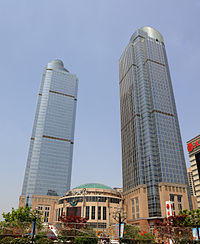Xujiahui

Xujiahui (simplified Chinese: 徐家汇; traditional Chinese: 徐家匯; pinyin: Xújiāhuì; Shanghainese:Zigawei), also spelt Zikawei or Siccawei, is a locality in Shanghai, China. It is a historical and cultural area located in Xuhui District.[1] The area is a well known precinct for shopping and entertainment in Shanghai.
| Xujiahui | |||||||
|---|---|---|---|---|---|---|---|
| Simplified Chinese | 徐家汇 | ||||||
| Traditional Chinese | 徐家匯 | ||||||
| |||||||
It is also the name of the metro station in the area, Xujiahui Station.
Name

Xujiahui literally means "Xu's junction" - or, more precisely, "property of Xu family at the junction of two rivers" in Mandarin [1]. The "Xu family" refers to the family of Xu Guangqi or Hsu Kuang-chi (1562-1633), China's most notable Catholic convert. Most of what is now present day Xujiahui was once the ancestral home of Xu Guangqi and his family. Baptized by famed Italian Jesuit, Matteo Ricci, Xu Guangqi and his descendants donated large plots of land to the Catholic Church, including the site of the St. Ignatius Cathedral.

Pronounced in the Shanghainese dialect of Wu Chinese, it is called "zi-ga-wei". During the 18th century it was known by Shanghai's western residents as "Ziccawei" (English) or "Zikawei" (French) and is still listed in a number of contemporary guidebooks and literature as "Zikawei" or some variant thereof.
History
With land donated by Xu Guangqi's family and those acquired by other means, the Society of Jesus established a grand cathedral as well as an entire one square mile complex that covers most of present-day Xujiahui. In addition to the cathedral, the French Jesus also built orphanages, monasteries, schools, libraries and the Xujiahui observatory.
In time to become the stronghold of Catholics in East Asia, one of the first structures to be built by Jesus was the St. Ignatius Cathedral in 1847, later reconstructed in 1906. The Cathedral is located on what is now known as North Caoxi Road and is still referred to in English as the St. Ignatius Cathedral. The sign on the street calls it simply "Catholic Church." The cathedral was featured in the opening scenes of Steven Spielberg's 1987 film Empire of the Sun.
Other structures that can still be seen today include Xuhui College on 68 Hongqiao Road, now renamed Xuhui High School (or Xuhui Middle School). Established by Jesus in 1850, Xuhui (St. Ignatius) College was the first educational institution in China to offer a fully western curriculum.
While central Xujiahui was administratively part of the Chinese area of Shanghai, it was in reality controlled by the Catholic Church, which was closely associated with the French authorities of the French Concession. From 1914, Xujiahui sat just outside the borders of the French Concession, and remained under heavy French influence.
Catholic Xujiahui came to an abrupt end with the Communist victory over the KMT. A few years after the People's Liberation Army entered Shanghai, Jesuits had abandoned Xujiahui and relocated to nearby posts like Macau or Manila. Many of those who remained were imprisoned by Communist authorities. These include Cardinal Ignatius Kung (Gong Pinmei), who spent decades in prison, and Father Chang-min "Beda" Chang, who died in prison in November 1951.

From 1949 onwards, most of the large houses and estates in Xujiahui were compulsarily acquired or seized by the government and converted into factories. Up until the late 1990s, the area was predominantly an industrial area.

Economy
During the late 1990s, many of the state-owned factories were sold off and torn down. Xujiahui is now mainly a retail district of downtown Shanghai.
Shopping
The main Xujiahui shopping district is centered around the intersection of the streets Hongqiao Rd, Huashan Rd, Zhaojiabang Rd and North Caoxi Rd. Each of these streets terminates at the intersection, which is home to three supermarkets, six major shopping malls and nine large-scale office towers. Everything from cosmetics to cars to cucumbers is available within five minutes, but the type of product that Xujiahui is most famous for is electronics. It is one of the biggest places for people to get electronic equipment, from cameras to PSPs to Xboxes and modchips for those Xboxes and other game consoles as well.
On the location of a former brick factory now stands the Xujiahui park, which was completed in 2002. The park also contains a man-made river (modeled after the Huangpu River) and meandering brook, basketball courts, and a children's playground. The Shanghai Conservatory of Music - located to the park - often stages free performances during the Spring and Autumn months in the park, as these are the times when weather in Shanghai is the best.
A five minute walk to the north of this intersection is the famous Shanghai Jiao Tong University.
Transportation
The main intersection at Xujiahui is a transportation hub. It is served by dozens of bus routes, and by the Xujiahui metro station on Lines 1 and 9 of the Shanghai Metro.
Xujiahui sub-district
Xujiahui was established in May 1994 as a sub-district of Xuhui District, Shanghai.[2] The sub-district covers 4.04 square kilometres. There are 31624 households which total 94872 residents. There are roughly 110000 permanent residents in the district.[2] The sub-district is not co-extensive with the geographical locality.
